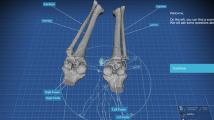Abstract
Human anatomy education has been traditionally taught using methods such as lecture and cadaveric dissection. Modern technologies that enhance 3-dimensional (3D) visualization, such as virtual reality (VR), are currently being implemented as adjuncts. VR technology provides a level of 3D visualization and interactivity that allows users to explore structures in ways that are often unattainable by direct cadaveric dissection. For example, users can experience simulations in which they can teleport themselves to structures inside of a virtual human body, resize and observe objects from any visual perspective, and draw in a 3D space to test their understanding. In the following study, the utility of VR in anatomy education was assessed and compared with traditional teaching methods including lecture and cadaveric dissection. A VR platform was created in which first-year medical students identified anatomical structures on a virtual cadaveric specimen and then drew these structures on a virtual skeleton using a 3D drawing tool. After completing these tasks, subjects answered survey questions that assessed the usefulness of the virtual platform for learning the names and locations of anatomical structures and understanding 3D anatomical relationships. The survey was also used to evaluate the perceived educational value of VR relative to lectures and cadaveric dissection. The results of our study showed strong subject support for VR technology, suggesting VR is a helpful tool for learning human anatomy and a useful adjunct to lecture and cadaveric dissection.





Similar content being viewed by others
References
Nicholson DT, Chalk C, Funnell WRJ, Daniel SJ. Can virtual reality improve anatomy education? A randomised controlled study of a computer-generated three-dimensional anatomical ear model. Med Educ. 2006;40(11):1081–7.
Moro C, Štromberga Z, Raikos A, Stirling A. The effectiveness of virtual and augmented reality in health sciences and medical anatomy. Anat Sci Educ. 2017;10(6):549–59.
Hoffman H, Vu D. Virtual reality: teaching tool of the twenty-first century? Acad Med. 1997;72(12):1076–81.
Chittaro L, Ranon R. Web3D technologies in learning, education and training: motivations, issues, opportunities. Comput Educ. 2007;49(1):3–18.
Silverstein JC, Ehrenfeld JM, Croft DA, Dech FW, Small S, Cook S. Tele-immersion: preferred infrastructure for anatomy instruction. J Comput High Educ. 2006;18(1):80–93.
Jastrow H, Hollinderbaumer A. On the use and value of new media and how medical students assess their effectiveness in learning anatomy. Anat Rec B New Anat. 2004;280(1):20–9.
Guimaraes B, et al. Rethinking anatomy: how to overcome challenges of medical education’s evolution. Acta Medica Port. 2017;30(2):134–40.
Hariri S, Rawn C, Srivastava S, Youngblood P, Ladd A. Evaluation of a surgical simulator for learning clinical anatomy. Med Educ. 2004;38(8):896–902.
Yammine K, Violato C. The effectiveness of physical models in teaching anatomy: a meta-analysis of comparative studies. Adv Health Sci Educ Theory Pract. 2016;21(4):883–95.
Garg AX, Norman G, Sperotable L. How medical students learn spatial anatomy. Lancet. 2001;357(9253):363–4.
Grogan K, Ferguson L. Cutting deep: the transformative power of art in the anatomy lab. J Med Humanit. 2018;39(4):417–30.
Brewer DN, et al. Evaluation of neuroanatomical training using a 3D visual reality model. Stud Health Technol Inform. 2012;173:85–91.
Stepan K, Zeiger J, Hanchuk S, del Signore A, Shrivastava R, Govindaraj S, et al. Immersive virtual reality as a teaching tool for neuroanatomy. Int Forum Allergy Rhinol. 2017;7(10):1006–13.
Ellis H. Teaching in the dissecting room. Clin Anat. 2001;14(2):149–51.
McLachlan JC, Bligh J, Bradley P, Searle J. Teaching anatomy without cadavers. Med Educ. 2004;38(4):418–24.
Kooi FL, Toet A. Visual comfort of binocular and 3D displays. Displays. 2004;25(2-3):99–108.
Bradley P. The history of simulation in medical education and possible future directions. Med Educ. 2006;40(3):254–62.
Author information
Authors and Affiliations
Corresponding author
Ethics declarations
Conflict of Interest
The authors declare that they have no conflict of interest.
Ethical Approval
NA
Informed Consent
Yes, IRB-approved study.
Additional information
Publisher’s Note
Springer Nature remains neutral with regard to jurisdictional claims in published maps and institutional affiliations.
Rights and permissions
About this article
Cite this article
Kolla, S., Elgawly, M., Gaughan, J.P. et al. Medical Student Perception of a Virtual Reality Training Module for Anatomy Education. Med.Sci.Educ. 30, 1201–1210 (2020). https://doi.org/10.1007/s40670-020-00993-2
Published:
Issue Date:
DOI: https://doi.org/10.1007/s40670-020-00993-2




